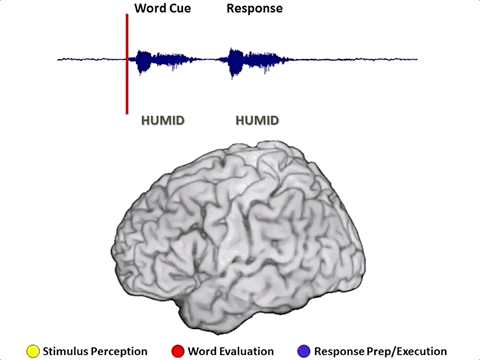Although neuroscientists have a general idea of what parts of the brain do what, catching them in the act is a difficult proposition. But UC Berkeley researchers have managed to do it, visualizing based on direct measurement the path of a single thought (or at least thread) through the brain.
I should mention here that as someone who studied this stuff (a long time back, but still) and is extremely skeptical about the state of brain-computer interfaces, I’m usually the guy at TechCrunch who rains on parades like this. But this is the real thing, and you can tell because not only is it not flashy, but it was accomplished only through unusually gory means.
Just want to see the thought go? Watch below. But continue reading if you want to hear why this is so cool.
Normal scalp-based electroencephalography (EEG) is easy to do, but it really can only get a very blurry picture of brain activity near the surface, because it has to detect all that through your hair, skin, skull, etc.
What if you could take all that stuff out of the way and put the electrodes right on the brain? That’d be great, except who would volunteer for such an invasive procedure? Turns out, a handful of folks who were already getting open-brain surgery did.
Sixteen epilepsy patients whose brains needed to be examined closely to determine the source of seizures took part in this experiment. Hundreds of electrodes were attached directly to the brain’s surface in a technique called electrocorticography, and the people were asked to do one of several tasks while their brains were being closely monitored.
 In the video (and gif) above, the patient was asked to repeat the word “humid.” You can see that first active is a part of the brain responsible for perceiving the word (the yellow dots, in one of the language centers); then, almost immediately afterwards a bit of cortex lights up (in blue) corresponding to planning the response, before that response is even fully ready; meanwhile, the prefrontal cortex does a bit of processing on the word (in red) in order to inform that response. It’s all slowed down a bit; the whole thing takes place in less than a second.
In the video (and gif) above, the patient was asked to repeat the word “humid.” You can see that first active is a part of the brain responsible for perceiving the word (the yellow dots, in one of the language centers); then, almost immediately afterwards a bit of cortex lights up (in blue) corresponding to planning the response, before that response is even fully ready; meanwhile, the prefrontal cortex does a bit of processing on the word (in red) in order to inform that response. It’s all slowed down a bit; the whole thing takes place in less than a second.
Essentially you’re watching a single thought process — “hear and repeat this word” — form and execute. Sure, it’s just colored dots, but really, most science is dots — what were you expecting, lightning bolts zooming along axons on camera?
In a more complex example (above), the person was asked to come up with the opposite of the word they hear. In this case, as you see below, considerably longer is spent by the prefrontal cortex in processing the word and formulating a response, since it must presumably consult memory and so on before sending that information to the motor regions for execution.
“We are trying to look at that little window of time between when things happen in the environment and us behaving in response to it,” explained lead author Avgusta Shestyuk in the Berkeley news release. “This is the first step in looking at how people think and how people come up with different decisions; how people basically behave.”
Ultimately the research was about characterizing the role of the prefrontal cortex in planning and coordinating brain activity, and it appears to have been successful in doing so — but the neuro-inclined among our readership will surely have already intuited this and will want to seek out the paper for details. It was published today in Nature Human Behavior.
